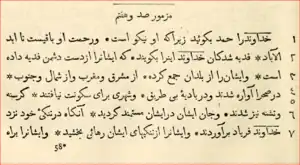Arabic typography is the typography of letters, graphemes, characters or text in Arabic script, for example for writing Arabic, Persian, or Urdu. 16th century Arabic typography was a by-product of Latin typography with Syriac and Latin proportions and aesthetics. It lacked expertise in the three core aspects of Arabic writing: calligraphy, style and system. Calligraphy requires aesthetically skilled writing in a chosen canonical style such as naskh, nastaʿlīq or ruqʿah. System denotes the script grammar covering such rules as horizontality and stretching.[1]
Characteristics
Some characteristics used in Latin scripts, like bold, letter spacing or italic, are not usually used in Arabic typography.
Calligraphic style
Some Arabic fonts are calligraphic, for example Arial, Courier New, and Times New Roman. They look as if they were written with a brush or oblong pen, akin to how serifs originated in stone inscriptionals. Other fonts, like Tahoma and Noto Sans Arabic, use a mono-linear style more akin to sans-serif Latin scripts. Monolinear means that the lines have the same width throughout the letter.
| Text example | Calligraphic (Arial) | Monolinear (Tahoma) |
|---|---|---|
| Eastern Arabic numerals | ٠١٢٣٤٥٦٧٨٩ | ٠١٢٣٤٥٦٧٨٩ |
| Abjad Hawz (ابجد هوز), an Arabic alphabet song | ابجد هوز حطي كلمن
شكل الاستاذ بقى منسجمن استاذ حمام .. نحن الزغاليل |
ابجد هوز حطي كلمن
شكل الاستاذ بقى منسجمن استاذ حمام .. نحن الزغاليل |
Overlines
Historically, Arabic text used overlines instead of underlines used in Latin script.[2]
Slant (italic)
Some Arabic styles such as Diwani use a right-to-left downward-sloping slant.[3]
Use of right angles
Some fonts use more right angles, for example Noto Kufi Arabic. Others, like Tahoma and Arial, have a more rounded style (see graph below). A font with tendency towards right angles is also called 'angled',[4] and rounded fonts are also called 'cursive'.[5]
 |
See also
- Cyrillic script § Letterforms and typography
- Naskh (script)
- Digital Arabic typography
- Category:Iranian typographers and type designers
- Typeface anatomy
- Category:Arabic typefaces
References
- ↑ Thomas Milo, Arabic Typography, Encyclopedia of Arabic Language and Linguistics, Brill Publishers, 2013
- ↑ Charette, François (2010). "ArabXeTeX: an ArabTeX-like interface for typesetting languages in Arabic script with XeLaTeX" (PDF). Archived from the original (PDF) on 2012-04-25. Retrieved 2011-10-10.
- ↑ "TPTQ Arabic: Arabic Calligraphy and Type Design by Kristyan Sarkis". tptq-arabic.com. Retrieved 2020-09-02.
- ↑ Zoghbi, Pascal (2019-03-14). "29LT Zarid Slab : A Firm & Agile Typeface". 29LT BLOG. Retrieved 2020-09-02.
- ↑ Zoghbi, Pascal (2019-03-14). "29LT Zarid Slab : A Firm & Agile Typeface". 29LT BLOG. Retrieved 2020-09-02.
Further reading
- "Text Layout Requirements for the Arabic Script". w3c.github.io.
